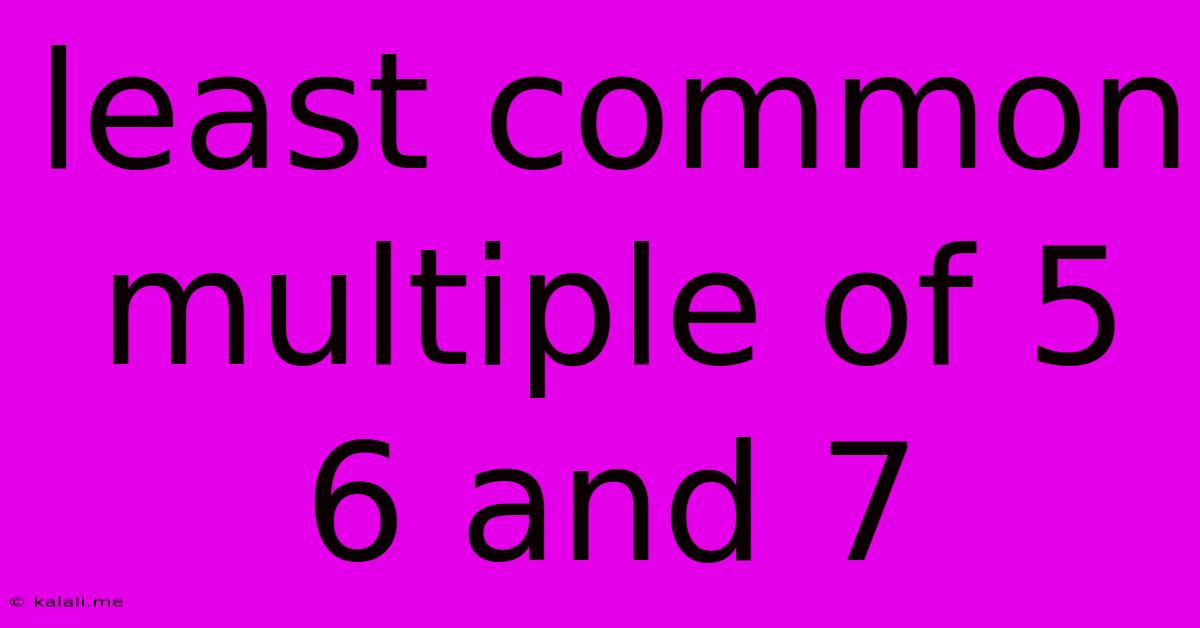Least Common Multiple Of 5 6 And 7
Kalali
Jun 13, 2025 · 3 min read

Table of Contents
Finding the Least Common Multiple (LCM) of 5, 6, and 7
This article will guide you through calculating the least common multiple (LCM) of 5, 6, and 7. Understanding LCMs is crucial in various mathematical applications, from simplifying fractions to solving problems involving cyclical events. We'll explore different methods to find the LCM, making this concept accessible to everyone, from beginners to those looking for a refresher.
What is the Least Common Multiple (LCM)?
The least common multiple (LCM) of two or more integers is the smallest positive integer that is divisible by all the integers. In simpler terms, it's the smallest number that all the given numbers can divide into evenly without leaving a remainder. This contrasts with the greatest common divisor (GCD), which is the largest number that divides all the integers without leaving a remainder. For example, the LCM of 2 and 3 is 6, as 6 is the smallest number divisible by both 2 and 3.
Methods for Finding the LCM of 5, 6, and 7
There are several ways to calculate the LCM of 5, 6, and 7. Let's explore two common methods:
1. Prime Factorization Method
This method involves breaking down each number into its prime factors. Prime factors are prime numbers that, when multiplied together, equal the original number.
- Prime factorization of 5: 5 (5 is a prime number itself)
- Prime factorization of 6: 2 x 3
- Prime factorization of 7: 7 (7 is a prime number itself)
Once you have the prime factors, you identify the highest power of each prime factor present in the factorizations. In this case:
- The highest power of 2 is 2¹ = 2
- The highest power of 3 is 3¹ = 3
- The highest power of 5 is 5¹ = 5
- The highest power of 7 is 7¹ = 7
To find the LCM, multiply these highest powers together: 2 x 3 x 5 x 7 = 210
Therefore, the LCM of 5, 6, and 7 is 210.
2. Listing Multiples Method
This method involves listing the multiples of each number until you find the smallest multiple common to all three. While straightforward, this method can become cumbersome with larger numbers.
- Multiples of 5: 5, 10, 15, 20, 25, 30, 35, 40, 45, 50, 55, 60, 65, 70, 75, 80, 85, 90, 95, 100, 105, 110, 115, 120, 125, 130, 135, 140, 145, 150, 155, 160, 165, 170, 175, 180, 185, 190, 195, 200, 205, 210...
- Multiples of 6: 6, 12, 18, 24, 30, 36, 42, 48, 54, 60, 66, 72, 78, 84, 90, 96, 102, 108, 114, 120, 126, 132, 138, 144, 150, 156, 162, 168, 174, 180, 186, 192, 198, 204, 210...
- Multiples of 7: 7, 14, 21, 28, 35, 42, 49, 56, 63, 70, 77, 84, 91, 98, 105, 112, 119, 126, 133, 140, 147, 154, 161, 168, 175, 182, 189, 196, 203, 210...
Notice that 210 is the smallest number that appears in all three lists.
Conclusion
Both methods confirm that the least common multiple of 5, 6, and 7 is 210. The prime factorization method is generally more efficient for larger numbers, while the listing multiples method is useful for smaller numbers or for a quick visual understanding. Understanding how to find the LCM is a valuable skill in various mathematical contexts and problem-solving scenarios.
Latest Posts
Latest Posts
-
Gpa Requirements For Fayetteville State University
Jun 13, 2025
-
Difference Between Growth And Development Biology
Jun 13, 2025
-
In What Country Is Lake Victoria
Jun 13, 2025
-
High Voltage Medium Voltage Low Voltage Ranges
Jun 13, 2025
-
Which Statement Is The Best Description Of An Ecosystem
Jun 13, 2025
Related Post
Thank you for visiting our website which covers about Least Common Multiple Of 5 6 And 7 . We hope the information provided has been useful to you. Feel free to contact us if you have any questions or need further assistance. See you next time and don't miss to bookmark.